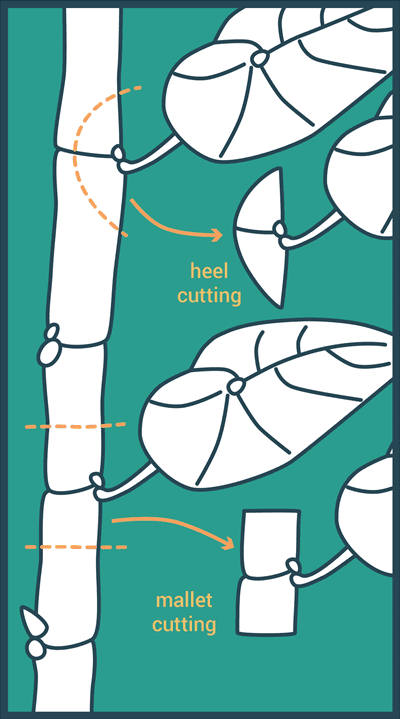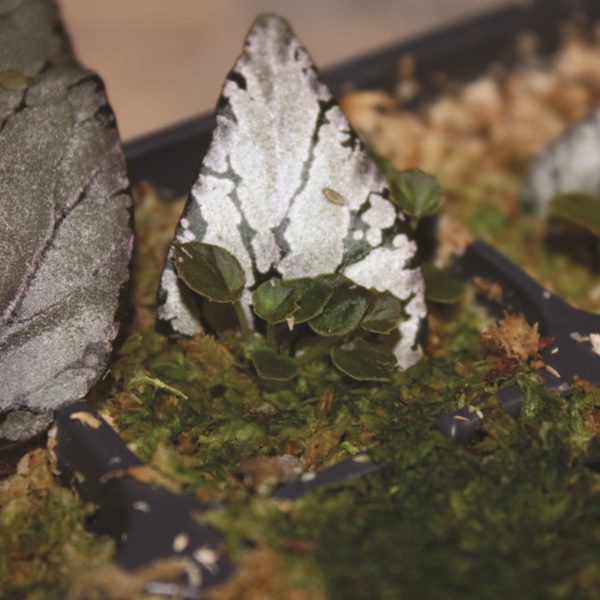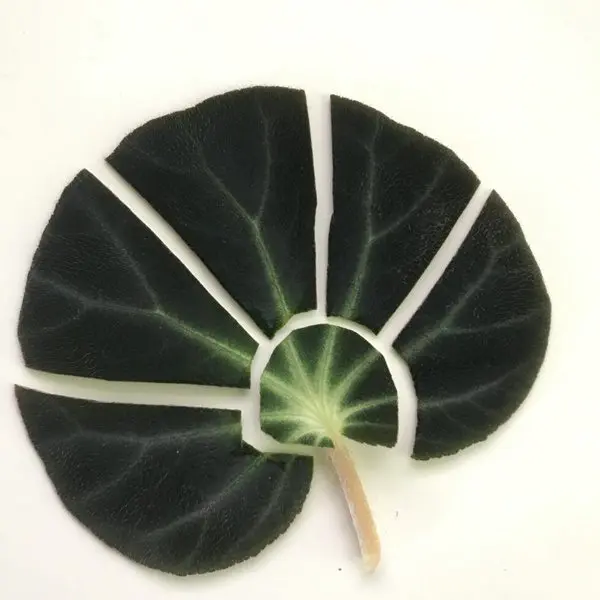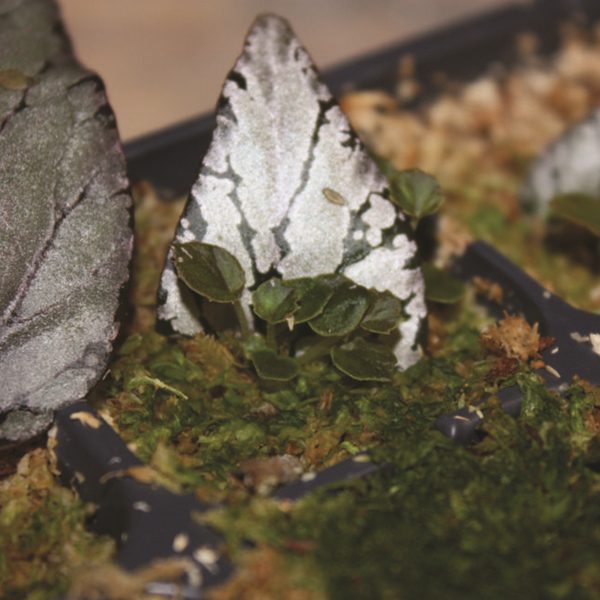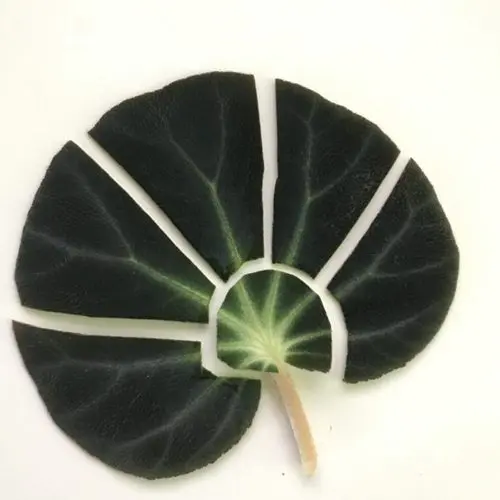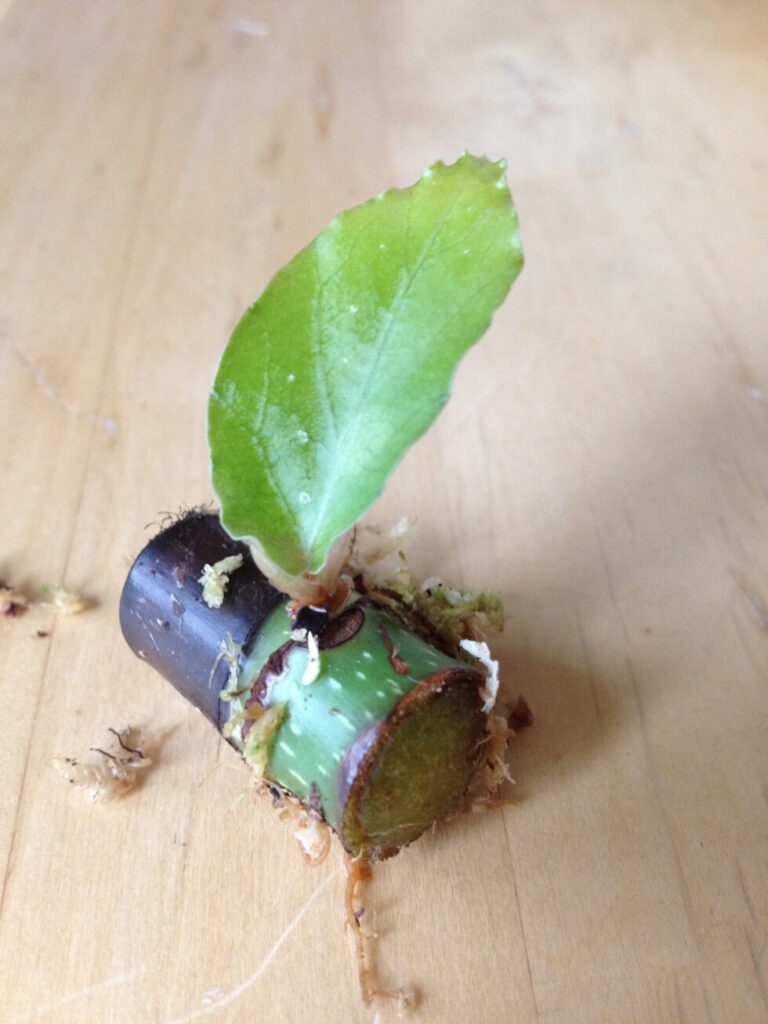Introduction
Cloning a plant occurs when rooting cuttings to form new plants. To keep hybrid DNA intact, it is necessary to reproduce new copies of Begonia hybrids by this method. It’s also an easy and quick way to make new plants of Begonia species. There are three basic types of Begonia propagation; stem cuttings, leaf cuttings, and division.
Propagation involves taking portions of a Begonia plant and rooting them to grow into new plants. Some types of propagation require more skill than others or more specialized conditions. Everyone should be able to propagate begonias without too much difficulty. This article contains descriptions and illustrations of the various types of propagation. Nearly all begonias can be started from a stem or tip cuttings. Rexes, rhizomatous, tuberous, and a few other types can be started from leaf cuttings or portions of leaves. All begonias can be divided except for some tuberous begonias.
Mediums
Perlite & Vermiculite, Sterile Mediums
A common medium for rooting cuttings is perlite, or in combination with vermiculite. Perlite and vermiculite are rock/mineral products, so contain no organic matter that can harbor disease or promote rotting and thus sterile. When using these products, you’re basically still rooting in water. They act as little rock sponges to hold water for the cutting to root in. They also contain air pockets. Perlite and vermiculite don’t require sterilization to use, although you do need to use distilled or sterile water to keep it sterile. When using either product, you should wear a mask or avoid breathing in the dust when mixing or pouring it.
Sphagnum Moss or Peat Moss
Another medium for rooting is sphagnum moss, or various combos of peat moss, perlite, and vermiculite. This works for all types of cuttings but unless sterilized, it may rot cuttings since it contains organic material. It is mostly used for stem cuttings or rhizome cuttings that don’t require sterile or specialized conditions. It’s also used for cuttings that are overly fleshy and tend to rot in water only.
Regular Mix
Many Begonia cuttings can be started directly in your potting mix in a shady location. Hardier rhizomes, shrubs, thick-stemmed and canes will start directly in mix.
Containers
There are many clear containers such as clear plastic take out containers, storage boxes, and commercial propagation boxes. A depth of 3-4 inches is adequate. Lid height should be able to clear your cuttings and allow for some growth before planting. Leaf and wedge cuttings require some type of container to root in. It has two benefits: humidity needed for rooting and keeping out spores that cause disease.
Supplies
Rooting mediums for leaf cuttings
The most commonly used medium for leaf cuttings is perlite. It is already sterile and holds the correct moisture without staying too wet. It’s only disadvantage is you have to check often to make sure it doesn’t dry out. Any medium such as sphagnum moss, vermiculite and combos will work fine as long as they are made or kept sterile and kept to the right degree of moisture.
Other Tools
Cutting Tools – The best cutting tool to use is a razor blade. Using a new blade means you have a sterile utensil that doesn’t have diseases from your plants outside. The razor cuts cleanly without crushing cells along the edge, drawing in water easily.
Sterilization
It doesn’t matter how sterile your medium is, if the cuttings you put into it have spores of disease on the leaf surface. The most common disinfectant for using on cuttings, is a five percent bleach solution or a peroxide solution. Another option is a fungicide mixed to the recommended strength on the bottle. Hormone dip and cinnamon can be used as a sterilization method as you dip the cut end into your cuttings. You can also use Physan(TM) following the directions on the bottle. You can spray a tray of cuttings with a fungicide after they are done, just to make sure nothing was missed. Hormone dip and cinnamon also can be used as a sterilization method as you dip the cut end into your cuttings. Make sure to wear gloves.
Types of Propagations
There are several basic requirements needed for starting cuttings, other than water propagation.
- warmth
- good light
- humidity
- and a sterile moist medium.
Light & Warmth
This is best provided by using fluorescent lights. A light stand, besides providing constant good light, also provides suitable warmth. Any area you can keep reasonably warm will work, however. If not using lights, you need an area with bright light but no sun. Since leaves need to be rooted in covered containers, any sun will overheat and cook the cuttings. Under lights, you can keep the lights as close to the top of the container as possible. Leave the lights on for at least 14 hours a day. You can leave them on continuously if desired.
The simplest medium to root cuttings is in water. Nearly all the types of cuttings will root in water, except for leaf section cuttings that require sterile conditions. The small containers are best for rooting in water. The reason for using a small container is that cuttings release a rooting hormone in the water as they root. The least amount of water, the more concentrated the hormone. You can put several cuttings per container. Once roots are half an inch long, they can be potted up in regular potting mix and grown on. Forget any myths you’ve heard about water roots, the cuttings will transplant just fine.
Tip & Stem Cuttings
Stem cuttings are probably the least difficult method of propagation. It is a method of propagation that can be used for most all types of begonias. Spring is usually the ideal time to take cuttings,however, cuttings may be taken at any time throughout the year.
A tip cutting has to have certain elements in order to grow a good plant. As a general rule, begonias won’t send out new growth from a node where they have previously had a bloom. Nearly all begonias that won’t grow from leaves, won’t send out growth from a node that has had a bloom. This doesn’t apply to tuberous, rhizomatous or rexes, as they will send out new growth from any rooted part of the plant.
The illustration at the right shows a typical Begonia stem and its various possible components. On a Begonia stem, there is a node above each leaf. This node can have a bud that will grow into a new stem someday, a flower cluster or remain dormant. Any node that doesn’t have flowers or the scar left after the flowers have fallen off, has a bud inside.
A good cutting needs to have one or nodes that have not bloomed in order to grow into a proper plant. Roots will grow from the bottom node below the soil line and new branches may grow from nodes above the soil line. The best cuttings are tip cutting that have nodes that have never bloomed.
When taking a tip or stem cutting, cut the stem about half an inch below a node that has not flowered. If the cut is closer, then the cutting may rot instead of rooting. When rooting the cutting, remove any leaves from the lower nodes first, since these leaves will be buried and will rot.
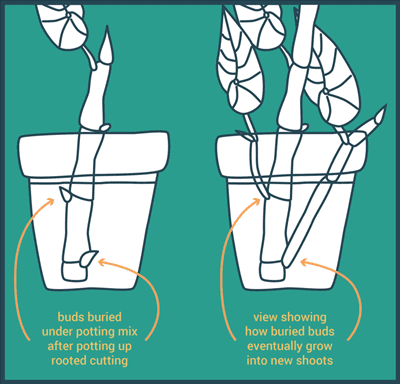
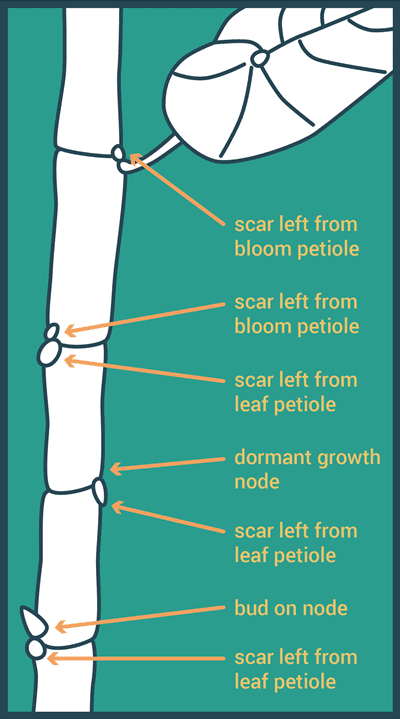
Put the cutting as low in the pot as possible covering at least one good bud. The buried buds will eventually grow into new shoots. Without a buried bud, the cutting will of course still root and grow. It won’t be able to send up new basal growth however. It will only be able to branch somewhere above the pot.
The only time you should use cuttings without buds to bury is if you’re going to grow a Begonia as a standard. Since a standard should be just one main stem, ordinarily bad cuttings are perfect for that purpose.
For begonias that are everblooming and hard to get good cuttings, first prune the plant. Then take cuttings from new growth when it comes.
Rhizome cuttings are a type of stem cutting. Unlike cane, shrub and other stem cuttings however, you don’t have to worry about nodes or bloom scars. Rhizome cuttings can be made any length and will give you a new plant faster.
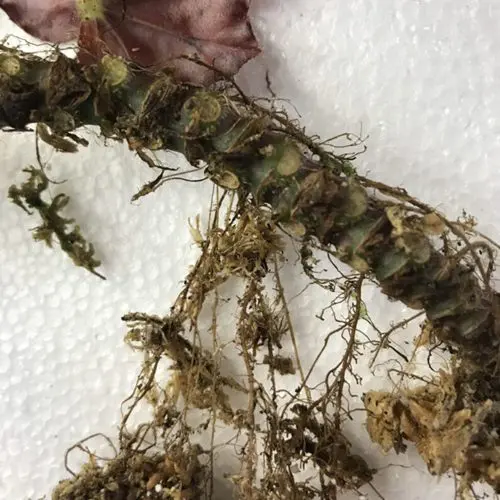
In the photo above the rhizome can be cut into two-inch sections. Most rhizomes can be rooted directly into your potting mix without any special considerations. The rhizome is fleshy and can easily maintain itself until roots and leaves form. Some more delicate varieties, such as rexes, may do better if rooted in an enclosed container providing humidity. Long rhizomes can even be rooted in water as you would any stem cutting. They are slightly more prone to rotting in water, however, since they are so fleshy. The rhizomes don’t have to have leaves to root and grow, and remove the largest leaves. Make sure the rhizome has good contact with the rooting medium, but not buried more than half way. Tip cuttings from rhizomes can be rooted upright with the cut end stuck one half to one inch into the rooting medium.
All parts of the leaf are capable of rooting and forming a new plant. The only requirement is that the leaf portion contain a main vein. There are three main types of leaf cuttings: full leaf cutting, wedge cuttings, and cone cuttings. If your purpose is to create a number of plants, you may choose to do wedge cuttings, since you can make many wedges from a single leaf. If your purpose is just to propagate a couple of new plants for yourself, you may choose to just use whole leaf cuttings. Cone cuttings are slower than regular whole leaf cuttings but since more veins are exposed to the rooting medium, the resulting plant is much fuller.
- warmth
- good light
- humidity
- and a sterile moist medium.
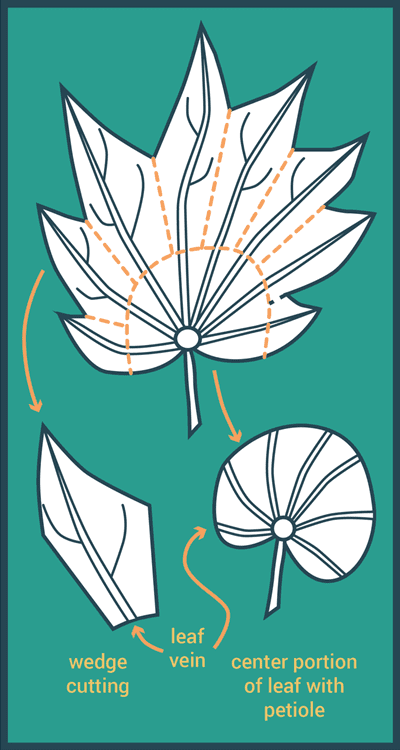
This is best provided by using fluorescent lights. A light stand, besides providing constant good light, also provides suitable warmth. Any area you can keep reasonably warm will work, however. If not using lights, you need an area with bright light, but no sun. Since leaves need to be rooted in covered containers, any sun will overheat and cook the cuttings. Under lights, you can keep the lights as close to the top of the container as possible. Leave the lights on for at least 14 hours a day. You can leave them on continuously if desired.
Containers For Leaf Cuttings
Most leaf cuttings need covered containers to root in. The purpose is to keep the humidity high and also to keep the medium sterile. The container can be as simple as a clear plastic cup covered with saran wrap for single cuttings, or an expensive tray with a clear dome. Plastic storage or take-out containers work well, recycle an aquarium, the possibilities are endless. You can even root leaf cuttings in zip lock bags. If you’re lucky enough to have a greenhouse, you can root leaf cuttings out in the open under a misting system. Even in a greenhouse though, you may choose to use covered containers for ease of use.
If you use a large container for several propagations, consider different varieties of begonias will grow at different rates, and be careful to use a clear labeling system and separations between varieties.
Using individual small pots for each cutting works well, because you can move cuttings from box to box as needed. If you’re using several boxes as things get potted up, you can recombine the slower rooting cuttings into one box. The disadvantage is that it is more time-consuming to fill all the individual pots and making separate labels for each. If you don’t mind the added time, it’s the better method.
Rooting Mediums For Leaf Cuttings
The most commonly used medium for leaf cuttings is perlite. It is already sterile and holds the correct moisture without staying too wet. It’s only disadvantage is that you have to check often to make sure it doesn’t dry out. Any medium such as sphagnum moss, vermiculite and combos will work fine as long as they are made or kept sterile and kept to the right degree of moisture.
To minimize the chance of rot, it is important to use sterilized cutting tools and surface areas, including the plant material.
In this photo, you can see a whole leaf propagation.
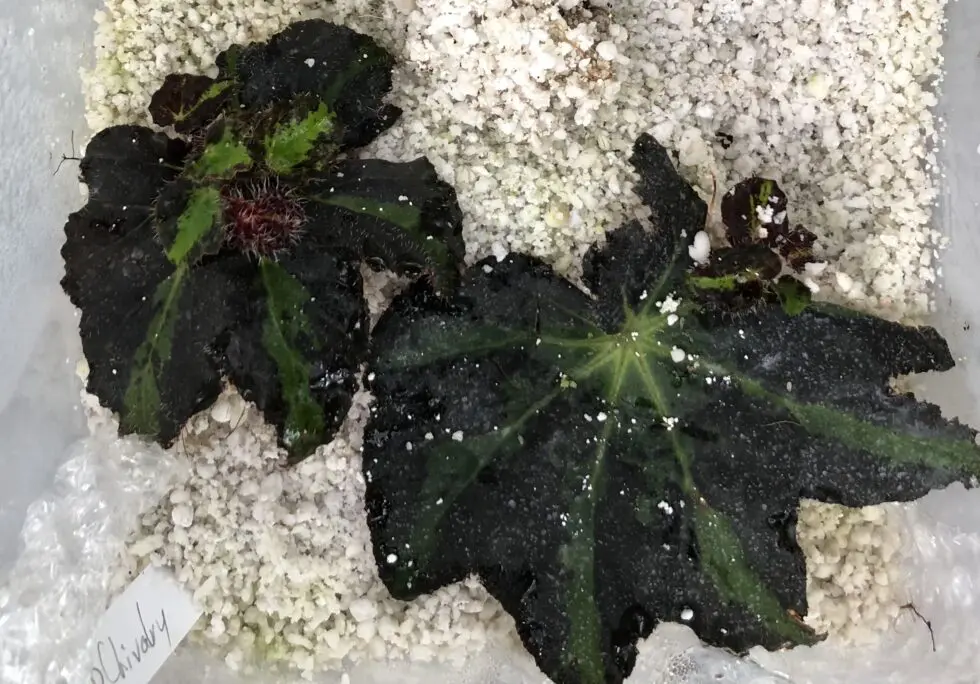
Whole leaf cuttings can be started without enclosed containers for some of the sturdier varieties. You can leave the petiole slightly longer and root them in small jars of water. You can also fill the small jar with perlite and add water. The second method does support the leaf better. You can also use pots of perlite set in a shallow tray of water. If you use any of these methods, don’t cover the container as the cuttings will usually rot with much water if covered. It does take practice and experience to find out which varieties of begonias will work with which methods.
Wedge Cuttings
Wedge cuttings are the easiest way to start many plants at a time with the least plant material. It’s especially useful for rare begonias or begonias that only have a couple good leaves to use. In the illustration you can see how to cut a leaf into wedges. A wedge is simply a portion of leaf with a vein in it. You can make your wedges as small or as large as you like. Smaller wedges may not survive if your conditions are less than perfect. A good rule is to make your wedgesI about an inch or inch and a half long.
For wedges, conditions must be as sterile as possible. As stated earlier in this chapter, a razor blade is the best utensil to use for cutting. Perlite is the best medium for rooting wedges. Add a very slight weak solution of fertilizer so the plantlets have some food when they start to grow. You can fill a tray with perlite and premoisten. When perlite is wet it becomes very solid. You can use a knife or plant label to make rows of small slits in the perlite the right size to fit the wedges. The wedges can be touching or overlapping, so don’t be afraid to pack them closely. Usually about half an inch to and inch apart works well. Try to insert the wedge as upright as possible. Also make sure to label carefully and keep different varieties separated. Try to mix the tray up so that varieties that aren’t a similar color aren’t next to each other so they don’t get confused later. They do require a covered container.
Wedges may take a couple months to form roots and plantlets. Check the moisture of the medium regularly to make sure it doesn’t dry out. Misting occasionally with a weak fertilizer for foliar feeding will help them along. You may want to leave the cover opened slightly till they dry off a little before closing tightly. Using distilled water will make sure that you don’t introduce any diseases into your sterile environment.
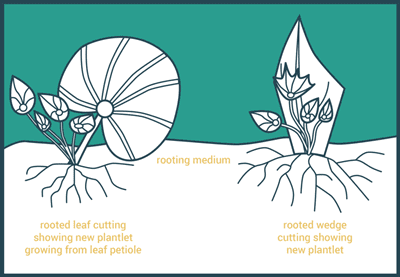
Cone cuttings are similar to wedge cuttings. You cut the center portion out of the leaf but instead of cutting it into sections, you leave it whole. You wind it around to form a cone and insert it into your rooting medium. Make sure to also put some medium inside the cone.
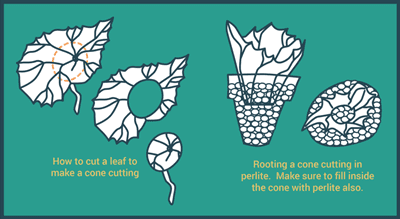
They can also be separated or cut apart to make many smaller plants after rooted and plantlets have formed.
On all the various leaf cuttings discussed in this chapter after plantlets have formed, you can either pot up the cutting along with the plantlet or you can remove the plantlet and use the cutting over again. Some cuttings will send up plantlets several times before they run out of energy if reused.
Mallet & Heel Cuttings
These types of cuttings are not commonly used, but they do have purposes. There isn’t much difference between the two and the mallet has less chance of errors or rotting so you shouldn’t use the heel version unless you have a specific purpose.
A mallet cutting will allow you to make a type of leaf-cutting from plants that ordinarily won’t start from leaves. Since the leaf-cutting contains a portion of the stem with a growth bud, it can be used for any type of Begonia. It’s mostly useful for creating as many plants as possible of a certain variety. Say you have a cane with one stem that has several nodes with good buds. If you propagate by stem cuttings, you might only get one or two cuttings.
